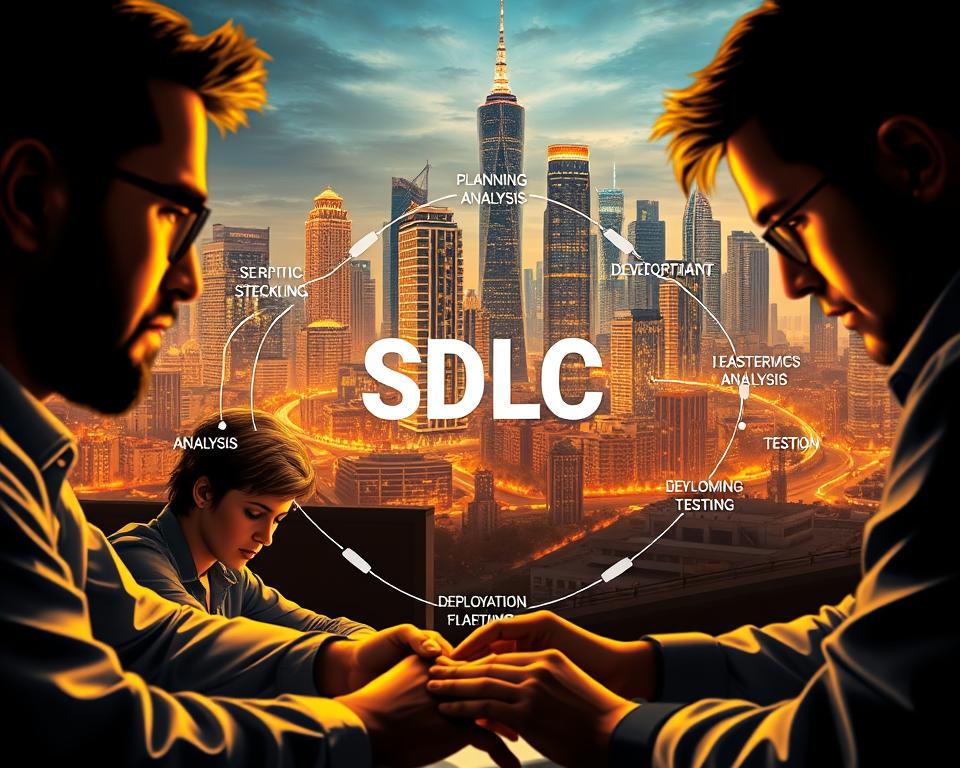
How Technology Transformed American History
Did you know that 90% of the technologies we rely on today were invented in the last 150 years? This staggering statistic highlights the profound *impact of technology in American history* and its role in shaping the country’s identity. From the colonial era to the digital age, *technological advancements* have driven economic growth, influenced societal changes, and transformed cultural landscapes. As we embark on this exploration of innovation in the US, we’ll delve into key inventions and milestones that have significantly altered the course of technology in American history, reflecting the ever-evolving relationship between technology and the American experience.

Key Takeaways
- 90% of current technologies were developed in the last century and a half.
- Technology has played a crucial role in shaping American society and economy.
- Key inventions have dramatically transformed various sectors in the US.
- The evolution of technology marks significant historical milestones.
- Understanding technology’s impact helps us predict future trends.
The Birth of Innovation in America
The journey of American innovation traces back to the colonial period, where early technology laid the groundwork for future developments. Settlers introduced various colonial tools to facilitate daily tasks, marking the beginning of a culture steeped in invention and adaptation.
Colonial Beginnings and Early Tools
In the early days of the American colonies, practical needs drove the creation of rudimentary tools. Items like the plow significantly transformed agriculture, enabling settlers to cultivate land more efficiently. Waterwheels also emerged as a valuable technological advancement, harnessing natural resources for tasks such as milling grain. These early tools symbolized the settlers’ ingenuity, reflecting a deep commitment to enhancing productivity and addressing challenges in their environment.
First Steps Toward Industrialization
As the colonies evolved, so did the tools and technologies in use. Early innovation led to the establishment of the first factories, setting the stage for mass production. In this formative period, ideas of efficiency began to take hold, paving the way for significant economic progress. This shift marked the transition from individual craftsmanship to a collaborative industrial effort, showcasing the role of American innovation in transforming the landscape of work and production.
| Colonial Tool | Purpose | Impact on Society |
|---|---|---|
| Plow | Improved farming efficiency | Enabled larger scale agriculture |
| Waterwheel | Powered mills and machinery | Laid foundations for industrial energy use |
| Hand tools | Construction and craft | Enhanced building techniques and productivity |
Key Inventions that Shaped America
Key inventions in US history have played a crucial role in how technology transformed everyday life. Two significant categories stand out: transportation innovation and communication technology. These advancements not only facilitated rapid movement across the country but also connected individuals and businesses in unprecedented ways.
Transportation Revolution: The Railroad and the Steam Engine
The introduction of the steam engine marked a turning point in transportation innovation. This revolutionary technology enabled the construction of railroads, creating a network that linked remote areas with bustling urban centers. As goods and people moved more efficiently, commerce flourished. The speed and reliability of railroads encouraged westward expansion, establishing new towns and accelerating economic growth. This showa the technology in American history
Communication Breakthroughs: The Telegraph and Telephone
The technology in American history is also the realm of communication technology, the telegraph emerged as one of the most significant inventions. Samuel Morse’s creation allowed for instant messaging across vast distances, changing how businesses operated and how news was spread. Following closely, Alexander Graham Bell’s telephone further revolutionized communication, offering real-time voice conversations. These innovations transformed personal relationships and business interactions, laying a foundation for future advancements.

Technology in American History: A Timeline
The evolution of technology in America showcases a compelling technology timeline filled with significant advancements that transformed society. Beginning with modest agricultural tools such as the plow and sickle, early settlers laid the foundation for future innovations. The adoption of steam power in the 19th century marked one of the first major technological milestones, dramatically changing transportation with the development of railroads and steamships.
As the country prospered, the invention of the telegraph in the 1830s revolutionized communication. This breakthrough facilitated instantaneous messaging across long distances, influencing not only personal connections but also commerce and governance. In the early 20th century, the introduction of the automobile further transformed American life, symbolizing freedom and mobility while reshaping urban landscapes.
Fast forward to the digital age, where personal computers and the internet emerged as game-changers in the late 20th century. These innovations epitomize the intersection of technology and everyday life, leading to new forms of communication, business, and entertainment. Each phase of this technology timeline reflects the cumulative impact of preceding inventions, showcasing how each technological milestone has built upon its forerunners to create the vast and complex tech landscape of today.
The Industrial Revolution: Impact on American Society
The Industrial Revolution represented a seismic shift in the fabric of American society, leading to profound changes in both labor dynamics and urban development. This transformation was characterized by notable labor shifts as workers transitioned from rural farming to urban factory environments. New job prospects emerged, captivating many individuals seeking better livelihoods. Nonetheless, this progress did not come without complications, including poor working conditions and emerging labor rights movements.
Shifts in Labor and Employment
As industrialization took hold, the nature of labor underwent significant changes. Many individuals who once toiled on farms began pursuing employment in bustling factories. The industrial revolution impact was evident in the growing demand for labor, which facilitated the creation of new job opportunities in cities. Workers often faced grueling hours and minimal safeguards, reflecting the need for labor reform. The transition disrupted traditional roles and defined a new era of employment.
Urbanization and the Rise of Factories
The surge of factories triggered a wave of urbanization, radically altering the demographic landscape of the United States. As economic opportunities flourished in industrial hubs, people migrated en masse to cities. This migration spurred the growth of urban centers, causing challenges such as overcrowding and inadequate infrastructures. Yet, it also fostered diverse communities and cultural exchanges that enriched American life.
Consider the following table that outlines the impact of labor shifts and urbanization during the Industrial Revolution:
| Aspect | Before Industrial Revolution | After Industrial Revolution |
|---|---|---|
| Primary Occupation | Agriculture | Factory Work |
| Work Environment | Rural Farms | Urban Factories |
| Working Conditions | Family-Based | Often Hazardous |
| Population Distribution | Rural | Urban |
| Societal Changes | Stable Communities | Dynamic, Migrating Populations |
Technological Advancements in the 20th Century
The 20th century witnessed unprecedented technological advancements driven largely by the demands of global conflicts. The World Wars catalyzed significant innovations in military technology, paving the way for developments that reshaped both the battlefield and civilian life in America.
World Wars and Military Innovations
Throughout World War I and World War II, military technology progressed rapidly. Innovations in aviation, tanks, and weaponry not only enhanced combat effectiveness but also laid the groundwork for post-war civilian applications. For instance, advancements in jet propulsion during the wars translated into commercial aviation breakthroughs after the conflicts ended.
Post-War Advances in Consumer Technology
The technological advancements achieved during the wars transcended military use, stimulating the growth of consumer tech. By the late 1940s and early 1950s, the suburban lifestyle began to flourish, thanks in part to innovations in automobiles and household appliances. Brands like General Motors and Whirlpool embraced these advancements, introducing products that significantly improved everyday living. The result was an American economy that thrived on innovation and consumerism, significantly transforming societal norms.
Digital Transformation in the 21st Century
The 21st century has witnessed a significant digital transformation, largely driven by the internet revolution. With the rise of digital technologies, traditional paradigms of communication, business, and social interaction have evolved dramatically. This transformation continues to impact various aspects of life in America, showcasing just how deeply technology influences contemporary society.
The Internet Revolution
The internet revolution has fundamentally altered how information is shared and consumed. Accessibility to vast amounts of data has empowered individuals and businesses alike. This change has resulted in a more informed public and created new opportunities for entrepreneurs and established companies. Tech giants such as Google, Amazon, and Facebook exemplify the shift in commerce and information sharing, embracing tools that facilitate rapid interaction and innovative services.
Social Media and Its Cultural Impacts
Social media platforms have emerged as powerful tools in this digital landscape. These platforms redefine communication by fostering real-time interactions between users. They also serve as marketing channels, allowing brands to engage with consumers directly. This accessibility influences not only personal connections but also societal trends and political movements. The cultural impacts of social media illustrate a groundbreaking shift, demonstrating how the internet revolution underpins the social dynamics of modern American life.
Historical Tech Developments: From Manufacturing to Computing
The landscape of technology has undergone remarkable transformations, particularly regarding historical tech developments that transition from manufacturing to computing. Early methods of production were labor-intensive and time-consuming, yet innovations revolutionized the approach to manufacturing. Mechanization introduced machines that could perform tasks previously done by hand, increasing efficiency and reducing labor costs.
As factories emerged during the Industrial Revolution, technological advancements reshaped production processes. The introduction of assembly lines allowed for faster and more consistent manufacturing, drastically changing how products were made. This pivotal shift not only improved productivity but also laid the groundwork for future tech developments.
With the advent of computers in the mid-20th century, the trajectory of technology continued to evolve. Businesses harnessed computing power to streamline operations, facilitate data management, and improve decision-making. The integration of software further enhanced organizational capabilities, resulting in exponential growth within various industries.
Ultimately, the journey from manufacturing to computing illustrates a continuum of innovation. Historical tech developments are not merely about the machines or software themselves; they embody a change in mindset towards efficiency and technological reliance, reshaping American society profoundly.
American Technological Progress and Economic Growth
In the United States, the landscape of technological advancements has significantly influenced economic growth. Startups play a pivotal role in this dynamic, offering innovative solutions and reshaping industries. The entrepreneurial spirit drives American technological progress, inspiring creativity and new ideas. Despite challenges, the vigor of startups reflects a robust ecosystem that fuels not only economic development but also societal enhancements.
The Role of Startups and Entrepreneurship
Startups represent the heartbeat of innovation in America. These enterprises contribute disproportionately to job creation and economic dynamism. They often introduce groundbreaking technologies, enhance productivity, and create new markets. The strong startup culture cultivates an environment where fresh ideas can thrive, supported by investors eager to back the next big innovation. Notably, sectors such as technology, healthcare, and renewable energy witness remarkable growth through startup contributions.
Government Support and Innovation
Government innovation support remains essential in nurturing a thriving technological ecosystem. Through strategic funding, grants, and conducive policies, the government enhances research and development efforts. Initiatives like the Small Business Innovation Research (SBIR) program and various state-level grants provide financial backing to startups. These programs reduce risks associated with experimentation, allowing entrepreneurs to focus on developing innovative solutions capable of advancing the nation’s technological forefront.
| Type of Support | Description | Impact |
|---|---|---|
| Grants | Funding provided to startups for research and development without requiring repayment. | Encourages exploration of new technologies and solutions. |
| Tax Incentives | Tax reductions for startups that invest in R&D and innovation efforts. | Motivates companies to allocate more funds toward tech advancements. |
| Policy Initiatives | Regulatory support aimed at easing barriers for new businesses. | Facilitates streamlined processes and faster market entry. |
Innovations in Healthcare: A Technological Narrative
The realm of healthcare has experienced a revolutionary transformation, driven by the rise of healthcare technology and groundbreaking medical innovations. Such advancements have markedly changed patient care, contributing to better health outcomes and broader access to essential medical services. Telehealth has emerged as a prominent facet of this innovation wave, enabling remote consultations and follow-ups, thereby enhancing the efficiency of healthcare systems.
From Medical Equipment to Telehealth
Recent developments in medical equipment showcase the shift towards more precise and efficient healthcare delivery. Modern devices allow for real-time monitoring of patient vitals, which can significantly reduce the need for in-person visits. This transition supports healthcare providers in making faster, evidence-based decisions. The integration of telehealth platforms further deepens this transformation, facilitating virtual check-ups and reducing barriers to care.
- Telehealth services empower patients in rural areas, ensuring access to specialists without the need for long travel.
- Wearable technology, such as smartwatches, tracks health metrics, allowing early detection of potential health issues.
- Advanced imaging technologies, like MRI and CT scans, provide detailed insights into patients’ conditions, improving diagnostic accuracy.
Each of these innovations illustrates how healthcare technology drives progress in the medical field, ultimately focusing on patient-centered care. The continuation of this trend suggests a future where telehealth services are an integral part of everyday health management, paving the way for a more connected and effective healthcare landscape.
The Role of Education in Technological Advancements
Education plays a pivotal role in shaping the future of technology. As society evolves, the need for skilled professionals in the fields of science, technology, engineering, and mathematics has become increasingly apparent. STEM education initiatives are crucial in cultivating an understanding of technology among students, preparing them for careers that will drive innovation and progress.
STEM Education Initiatives
Numerous programs across the United States focus on promoting education in technology through hands-on learning, mentorship, and community involvement. Schools and organizations collaborate to equip students with the skills needed for successful careers in technology-related fields. These initiatives focus on accessibility, encouraging participation from underrepresented groups and fostering a diverse talent pool. Notable programs include:
- FIRST Robotics: Engages students in robotics competitions to apply engineering principles and coding skills.
- Code.org: Provides resources and training for educators to teach computer science fundamentals.
- Project Lead The Way: Offers a curriculum that emphasizes project-based learning in engineering and technology.
Building Future Innovators
The cultivation of future innovators relies on fostering creativity, critical thinking, and problem-solving abilities in students. Education in technology must address not only the technical skills required but also the soft skills that enable collaboration and effective communication. By fostering an environment where students can experiment and innovate, we create a generation capable of tackling future challenges.
| Skill Set | Importance for Future Innovators |
|---|---|
| Technical Skills | Essential for understanding and utilizing advanced technologies. |
| Critical Thinking | Enables effective problem-solving and adaptability in dynamic environments. |
| Creativity | Drives innovation and the development of new solutions to complex challenges. |
| Collaboration | Encourages teamwork and collective efforts in achieving technological advancements. |
Environmental Technology: Addressing Climate Change
In recent years, the focus on environmental technology has become paramount in the fight against climate change. This sector emphasizes the integration of innovative solutions aimed at promoting renewable energy sources and enhancing sustainability. American companies and startups are spearheading significant initiatives to create technologies that contribute positively to both the economy and the environment.
Renewable Energy Solutions
Renewable energy serves as a cornerstone of environmental technology. Various forms of sustainable energy, including solar, wind, and geothermal power, are being harnessed to reduce dependence on fossil fuels. By utilizing these renewable resources, the U.S. is paving the way for a cleaner, more sustainable future. Companies like Tesla and First Solar are leading the charge, developing advanced solar panels and energy storage systems that make it easier for consumers to integrate renewable energy into their daily lives.
Green Innovation and Sustainability Efforts
Green innovation encompasses a wide array of technologies designed to support sustainability efforts across diverse industries. From smart agriculture that leverages IoT technology to optimize water usage, to sustainable construction practices utilizing recycled materials, the movement toward sustainability is gaining momentum. Additionally, startups across the country are focusing on waste reduction and creating products that adhere to circular economy principles. This holistic approach fosters an environment where environmental technology thrives, benefiting both businesses and society at large.
The Impact of Technology on American Culture
Technology has profoundly influenced American culture, reshaping how individuals communicate and experience entertainment. The advent of digital tools has marked a pivot point for interpersonal interactions, allowing for rapid communication changes that redefine relationships and social dynamics. These advancements bring about new implications for cultural expression and engagement.
Changing Communication Styles
With the rise of smartphones and social media platforms, the way people communicate has evolved significantly. Traditional conversations often take a backseat to quick texts and multimedia exchanges. This shift not only enhances connectivity but also facilitates cultural sharing across vast distances. Emojis, GIFs, and instant messaging have all emerged as prominent communication tools, reflecting a more visual and dynamic dialogue. As a result, real-time communication fosters a more interconnected community, enriching American culture.
Technology and Entertainment: A New Era
The landscape of entertainment technology has undergone a revolution, making media more accessible than ever before. Streaming services like Netflix and Spotify have transformed how people consume entertainment, enabling them to enjoy a wide array of content on-demand. This accessibility alters cultural consumption patterns, encouraging diverse content that reflects various perspectives. Interactive gaming platforms also engage audiences differently, creating experiences that blend social interaction with entertainment. The technology impact on culture is evident as these innovations encourage collaboration and creativity, significantly altering the fabric of American entertainment.
| Communication Style | Impact of Technology |
|---|---|
| Traditional Conversations | Shift towards texting and instant messaging |
| Community Engagement | Increased connectivity through social media |
| Cultural Sharing | Promotion of diverse voices and experiences |
| Entertainment Consumption | On-demand content accessibility |
Challenges and Ethical Considerations of Technological Growth
The rapid advancement of technology brings significant benefits, yet it also creates pressing challenges requiring attention. As society embraces innovation, issues related to privacy and the implications of automation warrant careful scrutiny.
Privacy Issues in the Digital Age
With the rise of digital technology, privacy concerns have emerged as a critical issue. Organizations collect vast amounts of personal data for various purposes, ranging from marketing to enhancing user experience. This extensive data collection raises important questions regarding consent and security. Individuals often remain unaware of how their information is used, leading to potential exploitation. Striking a balance between leveraging data for innovation and safeguarding personal privacy represents a significant ongoing challenge.
Job Displacement and Automation Concerns
Automation has transformed many industries, resulting in heightened efficiency and productivity. Unfortunately, this shift raises concerns about job displacement. As machines take over repetitive tasks, workers face the risk of redundancy. Addressing these automation concerns demands proactive measures, such as retraining programs to ensure workers adapt to the changing job market. Without proper planning, the socioeconomic impact of automation could exacerbate existing inequalities and create unrest among displaced workers.
Global Influence of American Technology
The prowess of American innovation has reshaped not only the nation but also the global landscape. Technologies developed in the United States have become pivotal in various industries, making the country a leader in exporting innovation worldwide. This strategic exportation highlights America’s crucial role in shaping international standards and trade policies, enhancing its standing in global technology influence.
Exporting Innovation Worldwide
American technology firms play a vital role in advancing innovation across the globe. Companies such as Apple, Microsoft, and Tesla have set the benchmark for technological advancement. Their products and services have significantly influenced markets around the world, driving a demand for new innovations. As nations adopt these American technologies, they often align their standards and regulations with U.S. practices, fostering a shared framework that accelerates growth and collaboration.
America’s Role in Global Tech Politics
Technology in American history is the realm of tech politics, the United States wields considerable influence. Strategic partnerships in research and development shape the future of global technology initiatives. This influence extends to navigating international trade agreements and intellectual property rights, ensuring that American innovation retains its competitive edge. As countries strive to enhance their tech industries, the principles set forth by American firms often serve as the gold standard across borders.
Looking Forward: The Future of Technology in America
The landscape of future technology presents a multitude of exciting possibilities, particularly with the emergence of innovative fields like artificial intelligence, quantum computing, and biotechnology. As these emerging technologies take center stage, they promise to revolutionize various sectors, from healthcare to transportation, enhancing efficiency and productivity. Understanding and embracing these advancements will be crucial for society to adapt effectively.
Emerging Technologies on the Horizon
In the coming years, technologies such as autonomous vehicles and advanced robotics will reshape industries while creating new job opportunities. Energy solutions like fusion power and improved battery technologies hold the potential to address climate concerns and shift energy consumption patterns. Preparing for these changes will require collaboration between businesses, governments, and educational institutions.
Preparing for Societal Changes Ahead
For preparing of societal changes people need to knoe the technology in American history.With the rapid pace of technological advancement, societal changes are inevitable. People will need to cultivate skills that align with future labor market demands, emphasizing the importance of continuous learning and adaptability. Investment in educational programs focused on emerging technologies can help nurture the innovators of tomorrow. By fostering a culture of innovation, society can navigate the transformative effects of these technologies while improving quality of life.
Conclusion
From the early tools of colonial times to the advancements in digital technology, the exploration of technology in American history reveals a continuous thread of innovation that has profoundly influenced societal progress. Each phase of technological development has brought about unique changes in communication, transportation, and entertainment, shaping the fabric of American culture. This summary of technological impact highlights how innovations not only transformed daily life but also positioned America as a leader in global influence.
As we contemplate the legacy of these technological advancements, it’s crucial to appreciate the lessons history provides. By understanding the technology in American history and its innovations, we can foster a more conscious engagement with current technologies and the even more advanced solutions on the horizon. The trajectory of technology in American history is ongoing, promising new opportunities and challenges alike, and inspiring us to think critically about our role in this evolving landscape.
In conclusion, the narrative of technological transformation is far from complete. As emerging technologies reshape our world, embracing an informed perspective will enable us to navigate these changes effectively. The future is bright, and as we look ahead, let us carry forward the spirit of innovation that has been a hallmark of American progress.





